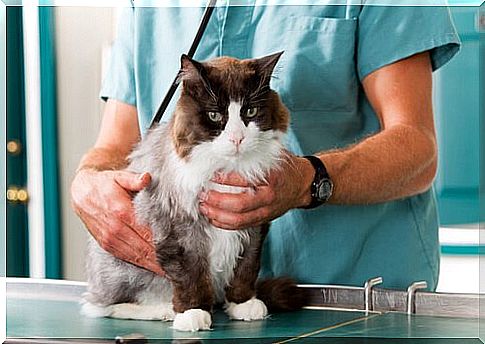What Exactly Is Toxoplasmosis In Cats?

This disease is transmitted by the parasite Toxoplasma godii . It is an asymptomatic disease and is not easily diagnosed. It can be transmitted from animals to humans, but humans normally get infected differently. There are many myths about toxoplasmosis in cats and the risks it poses to humans. Here we provide you with some information to demystify the disease a little.
What is toxoplasmosis in cats?
The Toxoplamsose is a contagious disease that is caused by one of the most widespread parasites of the world: Toxoplasma godii .
This organism can infect all mammals. The only animals that excrete it through their feces are cats. This means that they are the carriers or the ultimate hosts of the parasite. The other living things keep it in their body and you can only get infected by eating their meat raw or semi-raw.
Why do cats pass the disease on? In your organism there are certain conditions that lead to the biological cycle of toxoplasmosis developing in your intestinal phase.

Risks of infection for humans
Even if the saying goes otherwise, keeping a cat as a pet does not increase the risk. It is highly unlikely that a cat will infect a person, even if they are pregnant. Why? This is because different circumstances are required, which rarely occur at the same time.
- The animal must have been infected for the first time, as it becomes immune to the disease afterwards.
- The cat’s feces must be between 24 hours and 5 days old.
- The person must have hand contact with the feces and then put their hands in their mouths or touch food.
Even if the cat is infected, there is little chance that it will infect the people who live with it.
There are other situations in which people become infected more often. For example, if you eat raw or undercooked meat, infected fruit or vegetables, or if you drink unclean water.
Infection of other animals
In order to become infected, the cat must come into contact with the parasite by eating raw meat. For example, it could catch a rodent, bird, or other infected animal. Raw meat that was previously infected can also be contagious.
If we keep a house cat, it is likely that it gets its food at home – dry or canned food. Since she is only in little contact with sources of infection.
If it does catch the parasite, it takes about two weeks for toxoplasmosis to break out in the animal. It settles in the animal’s intestines, where it forms eggs that are expelled through the faeces.
Symptoms of toxoplasmosis in the cat
Since it is an asymptomatic disease, the animal does not show any clear signs. However, there are a few warning signs to look out for:
- diarrhea
- Loss of appetite
- fever
- Discomfort
- Difficulty breathing
- immunodeficiency
If we notice any of these symptoms, then we should take our paws to a veterinarian. The expert then draws his blood, makes a diagnosis and prescribes the appropriate treatment.
How to avoid illness in pets
With a little bit of precaution, it is possible that the cat will never be infected by the parasite:
- Keep her feeding place pure and watch what she eats. There are no problems if you give her cat food or homemade, cooked food.
- Avoid giving her raw meat to eat and see if she comes into contact with animals outdoors.
- Vaccinate them regularly and have them checked out by the vet. This is how you can check that she is healthy.
Treatment of toxoplasmosis
If the disease is diagnosed, then the vet will prescribe antibiotic treatment for at least two weeks. It all depends on the development and symptoms of the disease.

Home security
Toxoplasmosis in cats can therefore occur without any symptoms or after-effects. It is important to pay attention to diet and hygiene. If you see any sign of the disease, you should see your vet.
It is comforting to know that a house cat does not pose a real risk of infection for humans. You just have to pay enough attention to hygiene and cleanliness and watch the cat’s behavior.









